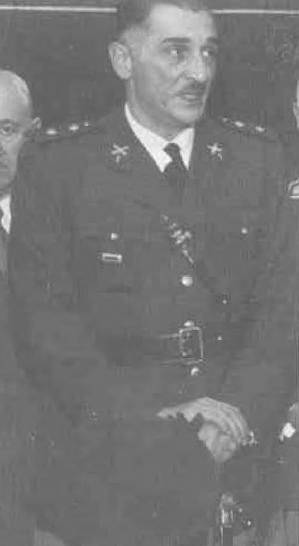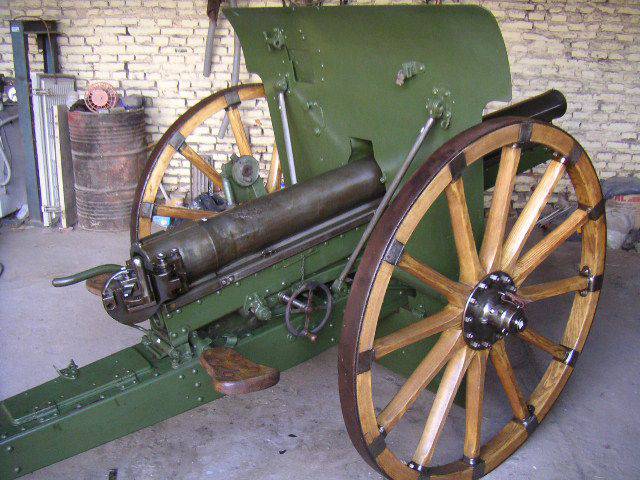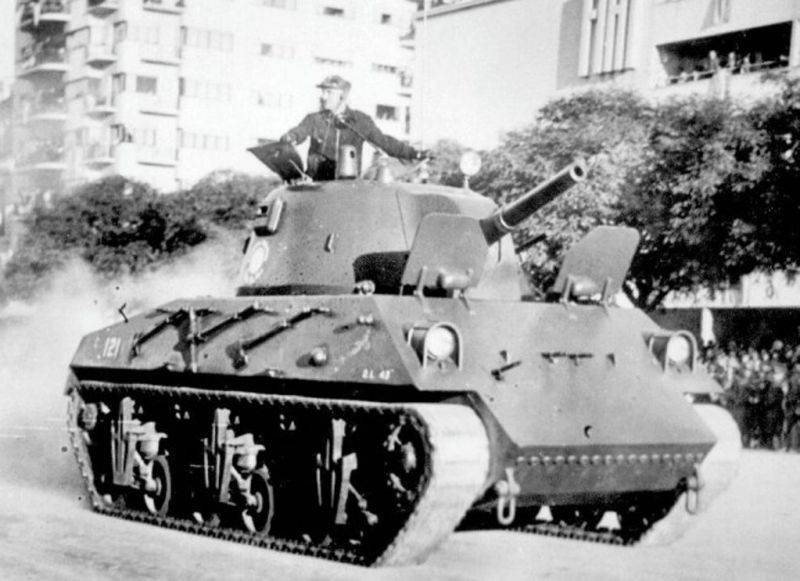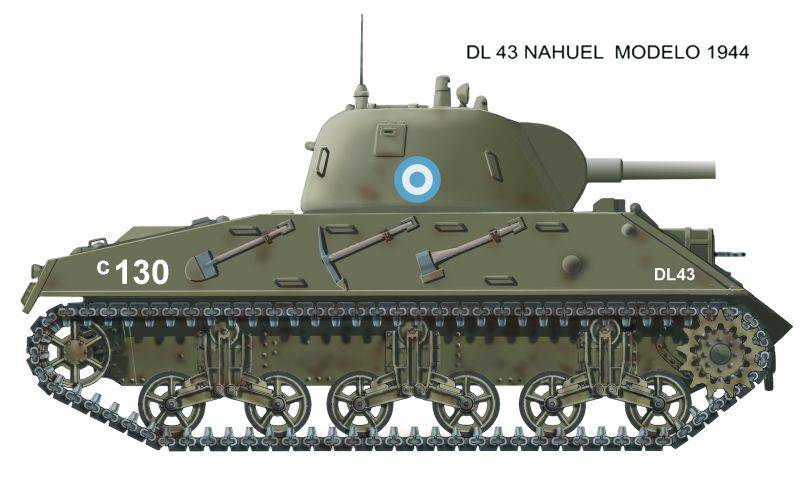"Nahuel" - tank "for the poor"
Tank "Nahuel" on the parade in Buenos Aires.
Alfredo Aquilis Baisi, a military engineer and lieutenant colonel in the Argentine Army, who was the director of the Arsenal Esteban de Luca military factory, began designing his national tank in 1943. Interestingly, he was born in a family of Italian émigrés and, like his father, chose for himself a military career, which he had developed very successfully. In the field of service, Alfredo Baisi performed the duties and the assistant military attache in the United States, and represented his country on the Inter-American Defense Council, and also worked as the director of a military factory, at the same time taking the post of first deputy minister of industry and commerce in the government. To all this, he was also a member of a group of officers who, in 1943, held a “pronunciamento” in the country - a forceful coup, removed President Ramon Castillo from power, and themselves took the place of the ruling elite. Therefore, their own tank, and not just any, but a good one, was desperately needed by them. Therefore, in addition to the tank, Baisi also developed an armored fighting vehicle with a machine gun based on an agricultural tractor called the Vitnchuk (a blood-sucking local insect), as well as a field uniform and a tank helmet. Due to a number of tensions with the government, he resigned, left his army posts, but continued to do research and published articles in various scientific journals, and died at the age of 73 years in 1975.

Lt. Col. Alfredo Aquilis Baci Designer Tank "Nahuel"
That is, the person had sufficient education and engineering experience for this, and besides, he was well versed in the production technologies of Argentinean plants, and was well aware of the possibilities of his national industry. Nothing superfluous was introduced into the design, nothing such that it would have been impossible for the Argentines at that time to “get” and put on their domestic tanks. In addition, it was necessary to take into account the possibility of war with Brazil, and various other difficulties that should not have prevented the production of new tanks in massive quantities.
I wonder how the tank got its name. Of course, Baisi knew that the Germans gave their tanks animal names and, apparently, decided to follow their example. That is why the first Argentine tank, designated as DL 43. got the name "Nahuel". This word, translated from the language of the Indians (that is, you will not carp - the national color!) Of the Araucan people meant “Jaguar”, and among them there was a legend about “tiger without teeth”, and what is interesting - that was what Argentina itself was called at that time. It is clear that the designer clearly lacked his own experience in such a complex business, and the Jaguar turned out to be quite similar (and in many ways!) To the M4 Sherman tank. But, on the other hand, that is why the design and development of the tank went pretty quickly, and its wooden layout in natural size was made after just 45 days, starting with the receipt of the order for the tank, and the first car left the factory only two months later . Well, the first copy, which had the number “C 252”, was privately demonstrated to the then leaders of the country: President General Edelmiro Farrell, Naval Minister Alberto Teisar and War Minister Juan Domingo Peron, after which they immediately gave the go-ahead to his mass production.
Production of the new tank was launched in 1943 at the Arsenal Esteban de Luca facility in Buenos Aires. At the same time more than 80 military and civilian factories of Argentina were connected to it. For example, enterprises of the air force assembled engines for it, factories of the military department smelted steel, the Ministry of Public Works was responsible for the chassis, rollers were processed at the Buenos Aires locomotive depot. The tower was made from photographs of the “Somau” and T-34 tanks, a five-speed (4 transmission forwards, 1 forwards) gearbox was designed and installed by Pedro Merlini, a car repair company, and electrical engineering was handled by specialists of the Army Communications Directorate. True, due to the weakness of the Argentine industry and the lack of spare parts, some of which were produced outside the country, in 1943 - 1944 the entire 16 was released (there is evidence that 12) of Jaguar tanks. Well, immediately after the war, the embargo on the supply of military equipment to Argentina was lifted and the need for an own tank immediately disappeared. It was clear that the countries of the anti-Hitler coalition would try to get rid of excess military equipment and would do it very soon.
The layout of the medium tank "Jaguar" was classic. The engine and transmission are aft of the tank, the fighting compartment in the middle, and the driver's seat in front. Armament was located in a closed tower, resembling a mushroom cap. The undercarriage design was borrowed from the M3 tank, and it had six rubberized rollers on board, connected in pairs in trolleys, and five rollers each supporting caterpillars. The front wheels of the tank, like the M3, were leading, the caterpillar consisted of 76 tracks. The V-shaped gasoline engine FMA-Lorraine-Dietrich 12EB with liquid cooling had 12 cylinders and had an 500 horsepower capacity. (365 kW). This ensured the speed of the tank in 40 km / h on the highway - that is, it had quite a decent operational-tactical mobility. As for the engine, in the 30-s the Argentines put it on a licensed French fighter "Devuatin" D 21, well, and then it was decided to decide it on this new tank. Cooled the engine radiator in the aft of the tank. Fuel supply was equal to 700 l, and the maximum power reserve - 250 km.
The hull was welded, which was quite modern, and it was assembled from sheets of rolled armor steel arranged with rational tilt angles. But there was nothing to do with armor for a tank, and according to some information, it had to be made from remelted armor from old ships, since the metal of a corresponding quality was simply absent in the country. Its thickness varied from 25 to 80 mm, and the thickest was exactly the front armor plate of the tank, where its thickness was 80 mm, and its angle of inclination was 65 °. For comparison, it should be noted that the frontal armor of the American Sherman M4A1 tank was 51 mm, and that of the T-34 tank was 45 mm. In this case, the lower front armor plate had a thickness of 50 mm - that is, quite decently, and its side armor plates, installed at an angle, the thickness of 55 mm. The bottom is unclear why it was surprisingly thick - 20 mm. Cast tower of chromium-nickel steel had a hemispherical streamlined shape. The frontal part of the tower had a thickness of 80 mm, onboard 65 mm, feed 50 mm, and the roof 25 mm (according to other data 20 mm). On the sides of the tower were made two viewing slots, which were covered with thick bulletproof glass. On the tank (this is truly a very modern solution, although not entirely justified in this particular case!), A special auxiliary engine was installed to turn the turret to 360 °. It is clear that if he failed, then it could be turned manually, but then it turned very slowly.
Armed with a Krupp L / 75 30 tank, the 1909 model of the year, which the Argentine army was armed with at the time, was designed even before the First World War. The maximum range of his shot was 7700 m, the initial velocity of the high-explosive fragmentation projectile 510 m / s, the initial speed of the armor-piercing projectile - 500 m / s, well, the rate of fire of the gun was about 20 per minute, which again was a very good indicator.

Krupp gun 1909 model year, standing on the tank "Nahuel".
The ammunition that was in the tank consisted of 80 projectiles that were in containers around the perimeter of the turret, where it was also possible to stack the spent cartridges. The tank had an 2-mm 12,7-mm anti-aircraft “Browning” (ammunition in 500 ammunition) and “Madsen” machine guns of the 1926 model, 7,62-mm caliber in the front upper hull (one of them on the left and two in the center), while on different tanks their number could vary, from 1 to 3 units. Ammunition for them was 3100 cartridges.
Interestingly, the radio station and TPU on the tank were German: the company "Telefunken". Inspection devices of the driver and gunner-radio operator were on the front hatches of the hull, and the commander's periscope on the roof of the tower with a viewfinder with a triple increase and with the ability to rotate it in different directions. The tower was equipped with a fan, sucking powder from it gases.
The tank crew consisted of five people: the commander, driver, gunner, loader and radio operator. The driver-mechanic and the gunner-radio operator were sitting nearby, behind a frontal armor plate. Commander, gunner and loader, as it should be, were placed in the tower. According to some reports, during the modernization of the tank, two of the three machine guns in the frontal hull were removed, and the crew was reduced to four people. Well, the weight of the tank was 34 tons (according to other data 36,1 - that is, at the level of the upgraded T-34 / 85). The tank had a maximum lift angle of 30 ° and a power reserve of 250 km.
It was not possible to fight this tank, but two cars showed the public already 4 June 1944, at the exhibition of the achievements of the Argentine industry. Tanks opened it with gunfire shots, while they were painted in olive-brown, round blue-white cockades of the colors of the Argentine flag were painted on the sides of the tower, and the inscription DL43 was on the front of the board, followed by a jumping jaguar.
9 July 1944, 10 tanks participated in a traditional military parade on Independence Day on Arenida del Libertador in Buenos Aires. The column of tanks on the head machine was headed by their creator, Lieutenant Colonel A. Baisi. Since then, these combat vehicles regularly showed people at parades dedicated to the independence of Argentina, in particular 9 July 1945 of the year and 9 July 1948 of the year, that is, used as the most real "PR-tanks", demonstrating the capabilities of the national industry of Argentina!
Tests have shown that the new tank does not differ in reliability, and most importantly - poorly armed. Therefore, in the 1947 year, at the suggestion of the director of the school of mechanized troops, José Maria Epifanio Sosa Molina, it was partially modernized. At the same time, his gun was replaced by a more powerful 75-mm gun from Bofors 75 / 34 M1935, firing armor-piercing and also high-explosive fragmentation shells. The first, weighing in 6,8 kg, had an initial speed in 595 m / s, the second - 7,2 kg and had a speed 625 m / s. In this case, an armor-piercing projectile at a distance of 500 m had armor penetration equal to 62 mm. That is, this tank could hardly fight the German tanks of the war period, but with the “local”, so to speak, could fight quite successfully.
With weapons "Jaguar" was removed in the 1948 year and replaced with tanks "Sherman". However, even after that they continued to be in the arsenals as a source for spare parts, and also used as targets for shooting practice. In 1950, the troops remained 13 such tanks. Two cars in 1953 seemed to have been presented to Paraguay during the visit of Argentine President Juan Perron to this country. Well, the last tank DL-43 was written off only in 1962 year. But not a single tank “Jaguar” has reached our days, unfortunately, it has not reached intact! So although all the ideas embodied in this tank were secondary, they, like the cubes from the children's designer, turned out to be folded so well that in the end its creators turned out to be a very good tank!
Fig. A. Shepsa.


Information